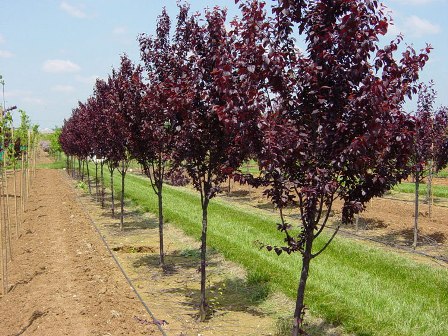
Pruning any tree is an extremely important task, but this is especially true for plum trees. As a fruit-bearing tree, an unkempt plum tree tends to produce less fruit. On top of that, the fruit that it does produce is much smaller. Pruning also helps keep the tree at a manageable size for easy harvesting. This is important because fruit that is left on the tree for too long can lead to insect infestation and disease. Below are tips on how to properly prune a plum tree.
When to Prune
The first thing that everyone needs to know about pruning is when to do it. Because different types of trees have different tolerance levels, the season in which one tree can be pruned is not always the same for another tree. It is best to prune plum trees during the middle of June to August on days when there is not a lot of moisture in the air; pruning a plum tree during rain or fog makes the tree susceptible to fungal infections. One of the most common fugal diseases that can take hold of plum trees is called silver leaf disease.
Frequency of Pruning
Training a plum tree to grow in a specific manner is a task that takes a lot of determination because the trees need to be pruned every year. This involves starting the pruning process when the trees are still young. After the first pruning, the tree should continue to be pruned every year.
Pruning Tools
Gardeners who already have pruning tools will be able to use these same tools to prune their plum trees. For those who do not yet have pruning tools, the following tools are required:
- Anvil blades or bypass blades – Anvil blades are straight, and bypass blades are more curvy. In general, bypass blades are easier to handle, and they cause less damage to the stems.
- Hand pruners – These are used for all stems that are less than .75 inches thick.
- Lopping shears – These are intended for use on all branches that are about 1.75 inches in diameter. They give the user more leverage because the handles are longer.
- Pole pruners – These have blades mounted onto poles. This makes it easier to cut branches that are high up. They are usually used on branches that are 2 inches in diameter.
- Chainsaw – For branches that are 3 inches thick or more, a chainsaw is required.
What to Cut When Pruning
Thankfully, plum trees are very resilient. This makes it hard to mess up the pruning process. It also means that landscapers can cut off as much of the plum tree as needed to help train it to grow correctly. During the first year, gardeners need to prune each branch of the tree by around 1/3 of its own length. It is best to prune right above a bud. The gardener should remove the uppermost bud and leave several other buds on the lower end of the branch. There should be around seven to nine strong branches stemming from the trunk of the tree at the end.
In the following years, the landscaper needs to turn their attention to removing dead or damaged branches from the tree. This includes removing any leaves that are starting to become discolored. It is also important to prune off any of the new branches that the tree starts to grow in order to help maintain the desired shape of the tree. If the tree starts looking too thick, the branches will need to be thinned out to help encourage ventilation. All branches that are low to the ground should be cut off as well to ensure the overall health of the tree.
Photo courtesy of CalTech
